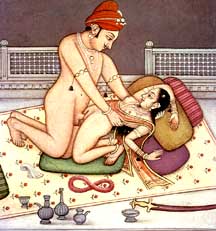Shiva Linga
Dr. Sreenivasarao Vepachedu, August 1996
According to Western Indologists, Shiva Linga is a wide spread
Indian Phallic figure. It consists of a feminine base ‘Yoni’ (womb) and a
rising masculine  portion ‘the Phallus.’ The
Linga artifacts, dating from the first century BC to the third century AD, are
shaped like realistic ‘Phalli’. Thereafter the shape becomes progressively more
abstract. By medieval times, its observable portion, rising from the Yoni,
forms a round block with domed apex. Shiva, the lord of erect Phallus (urdhvalinga), is traced to the ithyphallic figure of Indus
Valley civilization or to the phallic images found more generally in
prehistoric India.
portion ‘the Phallus.’ The
Linga artifacts, dating from the first century BC to the third century AD, are
shaped like realistic ‘Phalli’. Thereafter the shape becomes progressively more
abstract. By medieval times, its observable portion, rising from the Yoni,
forms a round block with domed apex. Shiva, the lord of erect Phallus (urdhvalinga), is traced to the ithyphallic figure of Indus
Valley civilization or to the phallic images found more generally in
prehistoric India.
However, linga in Sanskrit means
many things, in addition to phallus, womb, organ of generation, gender, etc.,
such as:
लिङ्ग
n. liGga landmark
लिङ्ग
n. liGga gender
लिङ्ग
n. liGga corpusdelicti
[concrete evidence of a crime]
लिङ्ग
n. liGga token
लिङ्ग
n. liGga symptom
लिङ्ग
n. liGga spot
लिङ्ग
n. liGga sign of guilt
लिङ्ग
n. liGga sign of gender or sex
लिङ्ग
n. liGga sign
लिङ्ग
n. liGga reason
लिङ्ग
n. liGga proof
लिङ्ग
n. liGga order of the religious student
लिङ्ग
n. liGga mark of disease
लिङ्ग
n. liGga invariable mark which proves the existence
of anything in an object
लिङ्ग
n. liGga inference
लिङ्ग
n. liGga idol
लिङ्ग
n. liGga guise
लिङ्ग
n. liGga evidence
लिङ्ग
n. liGga eternal or creative germ
लिङ्ग
n. liGga emblem
लिङ्ग
n. liGga disguise
लिङ्ग
n. liGga crude base or uninflected stem of a noun
लिङ्ग
n. liGga conclusion
लिङ्ग
n. liGga badge
लिङ्ग
n. liGga anything having an origin and therefore
liable to be destroyed again
लिङ्ग
n. liGga any assumed or false badge or mark
लिङ्ग
n. liGga characteristic
लिङ्ग
n. liGga mark
लिङ्गन
n. liGgana embracing
लिङ्गन
n. liGgana embrace
लिङ्गक
m. liGgaka wood apple [Limoniaacidissima-Bot.]
लिङ्गजा
f. liGgajA kind of plant
लिङ्गवत्
adj. liGgavat having various genders
लिङ्गवत्
adj. liGgavat having marks
लिङ्गवत्
adj. liGgavat containing a characteristic
लिङ्गत्व
n. liGgatva state of being a mark
लिङ्गतस्
ind. liGgatas from a mark
or sign.
In the context of divinity, linga obviously means image of a
god. For example, Ramalinga = Image or symbol of Rama, Shivalinga = image or
symbol of Shiva, etc. The epics and Puranas tell how a great fire appeared from the
cosmic waters, and from this flame Linga Shiva emerged to claim supremacy and
worship over Brahma and Vishnu.
The epics and Puranas
tell how a great fire appeared from the cosmic waters, and from this flame
Linga Shiva emerged to claim supremacy and worship over Brahma and Vishnu, when
he was castrated because he seduced sages’ wives in the pine forests of
Himalayas. He castrated himself because no one could castrate the Supreme Lord.
Thus fallen phallus of the Supreme Lord destroyed all the worlds until it
reached the Yoni of Uma/Parvati and cooled down. All
procreation of worlds started after the worship of Yoni-Linga was restored and
all Gods, including Vishnu and Brahma accepted supremacy of Lord Shiva.
However,
according to Puranas such as Linga, Shiva, Vamana, Skanda, etc., when He seduced sages’ wives in the pine
forests of Himalayas, He castrated himself because no one could castrate the
Supreme Lord. Thus fallen phallus of the Supreme Lord destroyed all the worlds
until it reached the Yoni of Uma/Parvati and cooled down. All procreation of worlds
started after the worship of Yoni-Linga was restored and all Gods, including
Vishnu and Brahma accepted  supremacy of Lord Shiva. Lord Shiva’s
other form is ‘Ardhanariswara’, half man and half woman. Lord Shiva, with his
consort Parvati, is always in a celestial dance of
procreation and destruction of the worlds. He is not only the embodiment of
‘Kama’ (the sexual lust, desire or pleasure, the force that is the basis for
the evolution of diverse life forms and Humans on earth) in the forms of Phallus
and androgynous Ardhanarishwara, but also the destroyer of ‘Kama’ when he
destroyed ‘Kamadeva’ only to restore his life at the request of Kama’s wife
Rati, ‘the coitus or the sexual intercourse.’ Without the sexual desire (Kama)
there is no sexual intercourse (Rati) and no procreation. Lord Shiva’s
manifestations are memorialized in the local texts of great shrines ranging
from temple complexes of Khajuraho in the north to Madhurai in the south.
supremacy of Lord Shiva. Lord Shiva’s
other form is ‘Ardhanariswara’, half man and half woman. Lord Shiva, with his
consort Parvati, is always in a celestial dance of
procreation and destruction of the worlds. He is not only the embodiment of
‘Kama’ (the sexual lust, desire or pleasure, the force that is the basis for
the evolution of diverse life forms and Humans on earth) in the forms of Phallus
and androgynous Ardhanarishwara, but also the destroyer of ‘Kama’ when he
destroyed ‘Kamadeva’ only to restore his life at the request of Kama’s wife
Rati, ‘the coitus or the sexual intercourse.’ Without the sexual desire (Kama)
there is no sexual intercourse (Rati) and no procreation. Lord Shiva’s
manifestations are memorialized in the local texts of great shrines ranging
from temple complexes of Khajuraho in the north to Madhurai in the south.
Shiva mythology, in fact, is a rich source of
Indian thinking about sexuality, social relations, ritual,  cosmic process, and
metaphysics. The Male-Female union in the form of “Phallus or Shiva Linga or
Yoni-Linga” or “the Ardhanarishwara” may be visualized as a parallel to
the Chinese philosophy of “Yin-Yang” or ‘the Male-Female.”
Metaphysically, it also is the most scientific philosophy that explains
fundamentals of existence through ‘positive and negative’ or ‘male and female’
aspects of matter and life. Moksha is only after Kama, of the four
principles of life-Dharma, Ardha, Kama, and Moksha.
Kama is a sacred duty of male and
female living beings as unit in the nature.
cosmic process, and
metaphysics. The Male-Female union in the form of “Phallus or Shiva Linga or
Yoni-Linga” or “the Ardhanarishwara” may be visualized as a parallel to
the Chinese philosophy of “Yin-Yang” or ‘the Male-Female.”
Metaphysically, it also is the most scientific philosophy that explains
fundamentals of existence through ‘positive and negative’ or ‘male and female’
aspects of matter and life. Moksha is only after Kama, of the four
principles of life-Dharma, Ardha, Kama, and Moksha.
Kama is a sacred duty of male and
female living beings as unit in the nature.
Unfortunately, some of us are ashamed of it because of Christian and Islamic influences. It was unacceptable, shameful and sinful to the Christians. They denounced it without understanding the culture, wrote demeaning articles, made laws and were able to influence the population to some extent. Their purpose was to teach us (the cultures which consider sex as sacred) the true path to God, the Christianity that considers sex as sin and purification of which is attained only by the blood of Jesus, the savior. Victorian Christians had the same kind of shock when they colonized Polynesian islands, for those islanders were sexually explicit in their lifestyle. The shocked Christian missionaries vowed and succeeded to eradicate the satanic culture by converting them to Christianity!
Fortunately, in the Indian continent non-Christians and non-Muslims still survive and continue age-old practices of respect for nature, animals and recognize the sacred aspect of sex. That is why we are considered an old and continuing civilization without any break, while our brethren in Europe lost their religion and culture totally to Christianity. The Indian reformers, with the British influence and help, got rid of some oppressive customs like Devdasi, Basivi, Sati etc., that forced women into prostitution and self-immolation in the name of religion. Ironically, today the Indian society looks down upon the west as a promiscuous society, and attempts to protect itself from the western vulgarity, indiscrimination and extramarital sex by censorship, a legacy of puritanical Christian and Islamic influence, while maintaining the sacred sensuality in the religion and within the marriage.
Mrs. Kalanidhi
Narayanan, a Bharata Natyam
teacher explained, 'the sex in the life is like food  and
sleep, without which there is no life. If you consider sex is sacred, it is
sacred. But if you think it is sin, it is sin. It depends on your outlook.'
She pointed out several poses and gestures in the Bharata
Natyam that explicitly and implicitly point to 'Rati Sukha Saaram,' (the essence of
the pleasure of sexual intercourse) in the love
affair of Radha-Krishna, where the sexual union of Radha and Krishna is at a philosophical level the union
between the God and the devotee, while at a physical level simply sex. What you
see depends on your mental status and outlook.
and
sleep, without which there is no life. If you consider sex is sacred, it is
sacred. But if you think it is sin, it is sin. It depends on your outlook.'
She pointed out several poses and gestures in the Bharata
Natyam that explicitly and implicitly point to 'Rati Sukha Saaram,' (the essence of
the pleasure of sexual intercourse) in the love
affair of Radha-Krishna, where the sexual union of Radha and Krishna is at a philosophical level the union
between the God and the devotee, while at a physical level simply sex. What you
see depends on your mental status and outlook.
We all have freedom to convert to any religion we like. But, there is no need to distort and censor the sexuality of the truth and origins of Linga. Hindu Religions like Saktism, Shaivism, Vaishnavism have a sacred sensual aspect to them. Let Truth Prevail.
(This article was written in response to a discussion on sexual nature of Shiva Linga. The purpose of the article is truth but not defense of Hinduisms (Indian Religions) like Shaivism or Vaishnavism or Tantrism (Yoni Tantra) or Saktism.)
Back to Mana Sanskriti
Back to The Telangana Science Journal
Back to Vepachedu Home Page

